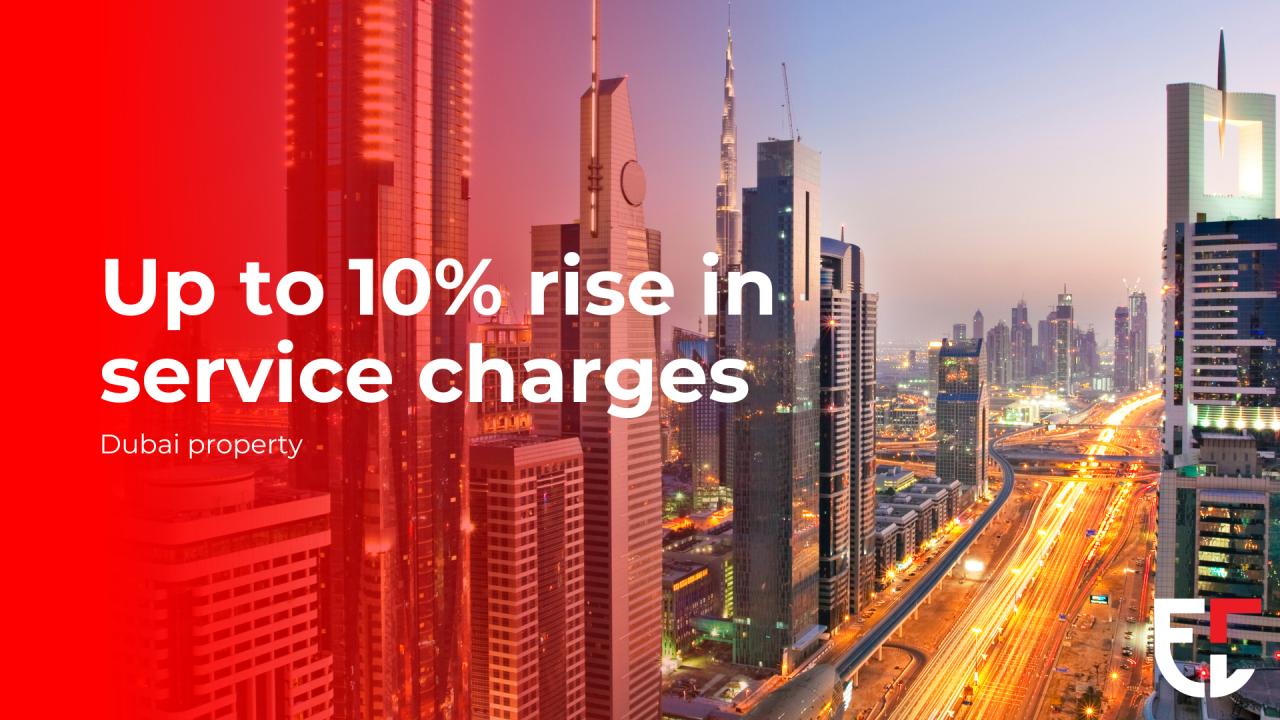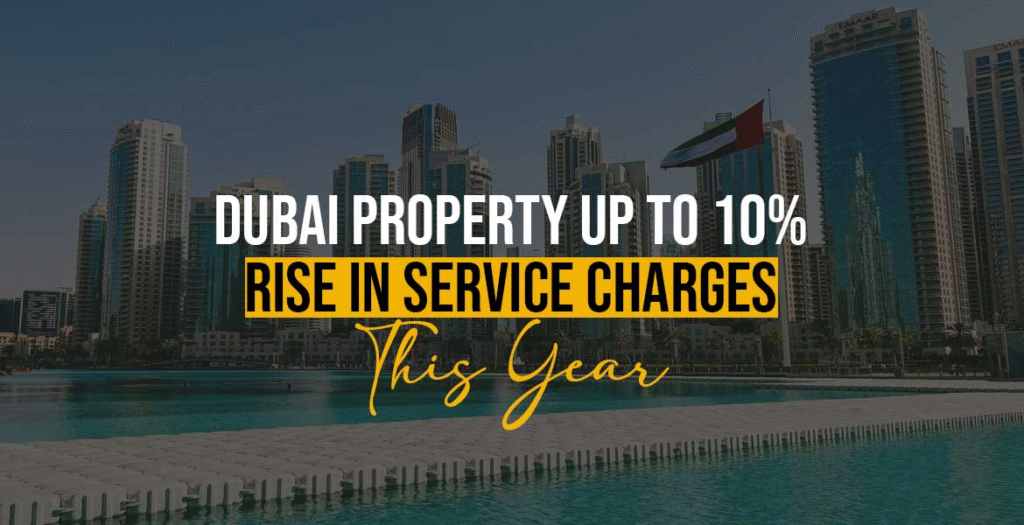
Service Charge Increases : Dubai’s real estate market in 2025 remains a top investment destination, with 99,000 transactions worth AED 326.7 billion in H1 and average rental yields of 6-10%, per Dubai Land Department (DLD) data. However, service charges mandatory fees for maintaining communal areas like pools, elevators, and security are rising 5-10% in 2025, impacting net rental yields, which can drop 10-25% after expenses.
These charges, regulated by the Real Estate Regulatory Agency (RERA) via the Mollak system, vary by community, with luxury areas like Palm Jumeirah facing higher fees than affordable zones like Jumeirah Village Circle (JVC). With 90-95% occupancy rates and 13-18% rental increases forecast for 2025, landlords often pass costs to tenants, but RERA’s rental index caps limit this.
The First-Time Home Buyer Program’s 5% discounts and Golden Visa for AED 2 million+ investments drive demand, yet rising service charges challenge profitability. Below are six service charge increases affecting rental yields in 2025, with strategies to mitigate their impact.
Inflation is pushing up Dubai Electricity and Water Authority (DEWA) tariffs and district cooling fees, increasing service charges by 5-8% in 2025. In Downtown Dubai, service charges average AED 20/sq.ft., with cooling fees adding AED 2-4/sq.ft. For a 1000-sq.ft. apartment yielding AED 100,000 annually (7% gross yield), a AED 2,000-4,000 increase in cooling fees cuts net yield to 6.5-6.7%.
Tenants face higher bills, reducing landlord pricing power under RERA’s rent cap (e.g., 10% max increase if rent is 21-30% below market). To mitigate, invest in energy-efficient properties in JVC or Dubai South, where service charges are AED 10-15/sq.ft., and negotiate fixed cooling inclusions in leases.
Older properties, built 10-15 years ago in areas like Dubai Marina, face 8-10% service charge increases due to infrastructure upgrades like elevator replacements or HVAC overhauls. A 1200-sq.ft. Marina apartment at AED 18/sq.ft. service charge, yielding AED 120,000 annually (6.5% gross), sees fees rise from AED 21,600 to AED 23,760-24,840, dropping net yield to 6-6.2%.
RERA’s Mollak system ensures transparency, but owners bear costs during voids. Target newer off-plan projects in Business Bay, with lower maintenance fees (AED 12-15/sq.ft.) and 70/30 payment plans, or budget 10-15% contingencies for older properties to maintain yields.

Dubai’s 2040 Urban Master Plan emphasizes sustainability, mandating energy-efficient upgrades like solar panels or LED systems, adding 3-5% to service charges in 2025. In Dubai Hills Estate, service charges of AED 15/sq.ft. for a 1500-sq.ft. villa yielding AED 150,000 (6.7% gross) increase by AED 675-1,125, reducing net yield to 6.5-6.6%.
Developers like Emaar pass 30-50% R&D tax credit savings, but upfront costs persist. Investors can offset this by choosing eco-certified projects in Dubai South, with lower fees (AED 10/sq.ft.) and 7-9% yields, or leveraging R&D credits via QFZP structures for 0% corporate tax.
Luxury communities like Palm Jumeirah and Bluewaters invest in premium amenities concierge services, upgraded gyms—driving 7-10% service charge increases. Palm Jumeirah’s AED 25/sq.ft. fees for a 2000-sq.ft. apartment yielding AED 200,000 (6.7% gross) rise from AED 50,000 to AED 53,500-55,000, cutting net yield to 6.2-6.3%.
High demand (17% rent growth in 2024) allows partial cost pass-through, but RERA caps limit raises. Focus on mid-market areas like Arjan (AED 10-12/sq.ft., 7.6% yields) or negotiate tenant contributions for premium amenities to preserve yields.
Sinking funds, allocated for major repairs like roof or facade upgrades, are increasing 5-7% in 2025 to address aging buildings, per RERA guidelines. In JVC, a 1000-sq.ft. apartment with AED 12/sq.ft. service charge, yielding AED 60,000 (7.5% gross), sees fees rise from AED 12,000 to AED 12,600-12,840, lowering net yield to 7.2-7.3%.
Low sinking fund reserves risk special levies, further eroding yields. Check Mollak’s Service Charge Index for fund health and invest in newer communities like Damac Hills 2 (AED 10/sq.ft.) to minimize future levy risks.
Rising insurance premiums and enhanced security measures, like AI surveillance, are boosting service charges by 4-6% in 2025. In Business Bay, a 800-sq.ft. apartment with AED 15/sq.ft. fees, yielding AED 80,000 (7% gross), faces a AED 480-720 increase, reducing net yield to 6.8-6.9%.
High-demand areas (16% apartment rent growth in 2024) support partial rent hikes, but RERA’s 90-day notice and caps apply. Opt for communities with competitive tendering, like Dubai Production City (AED 10/sq.ft.), or budget reserves for voids to sustain yields.
Service charges, consuming 10-25% of gross rental income, directly erode net yields, especially in luxury zones (AED 20-25/sq.ft.) versus affordable areas (AED 10-15/sq.ft.). Dubai’s 7% average gross yield (higher than London’s 2.4%) drops to 5-6% net after fees, per Global Property Guide.
With 182,000 new units by 2026, supply may ease rent growth, limiting cost pass-through under RERA’s updated Smart Rental Index, which uses AI to align rents with market rates. Hidden costs like 4% DLD fees and 2% commissions (+5% VAT) further strain budgets, though tax-free income and 90-95% occupancy sustain appeal.
Calculate net yields: Use (Annual Rent – Service Charges – Expenses) ÷ Purchase Price × 100. For a AED 1 million JVC unit with AED 60,000 rent and AED 12,000 fees, net yield is (60,000 – 12,000) ÷ 1,000,000 × 100 = 4.8%. Target affordable zones like JVC or Dubai South (7-9% yields, AED 10-12/sq.ft. fees). Verify rates via Mollak or DLD’s Service Charge Index.
Budget 10-15% contingencies and reserve funds for voids. Negotiate tenant contributions for cooling or amenities. Use QFZP entities in Jebel Ali Free Zone for 0% corporate tax or DIFC/RAK ICC to avoid 9% rental tax. U.S. investors leverage Form 1118 for tax credits; Muslim investors account for 2.5% Zakat (e.g., AED 1,500 on AED 60,000 rent).

Dubai’s 6.2% GDP growth, 4 million population projection, and infrastructure like Al Maktoum Airport fuel demand, per DLD’s AED 761 billion 2024 transactions. Prime areas like Downtown Dubai (6.3% yields) face higher service charge hikes, while emerging zones like Dubai South offer stability.
Oversupply (76,000 units) may moderate rents, but 10-12% apartment rent growth is expected. RERA’s transparency and 30-50% R&D credits for eco-tech support long-term ROI. Investors prioritizing low-fee communities maximize tax-free yields in a resilient market.
Inflation-driven utility hikes, aging infrastructure, sustainability mandates, premium amenities, sinking fund increases, and insurance surges are six service charge increases cutting Dubai’s rental yields in 2025. Consuming 10-25% of gross income, these fees drop net yields from 7% to 5-6%. By targeting affordable zones, budgeting contingencies, and leveraging tax-free structures, investors can safeguard returns in Dubai’s high-demand, tax-advantaged market. Service Charge Increases Affecting Rental Yields
read more: Dubai Property: 5 Developer Tax Incentives Shaping Off-Plan Sales 2025
